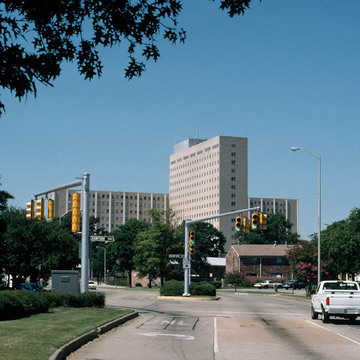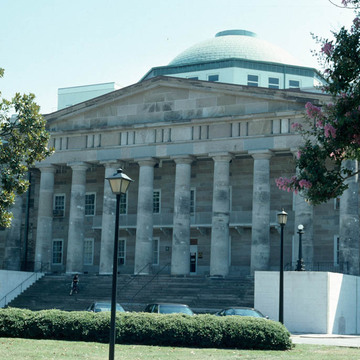The navy has maintained a continuous presence in Portsmouth since the eighteenth century. Built when the bureaucracy of the federal government was just beginning to expand, the original building of the U.S. Naval Hospital at Portsmouth has proven its adaptability through more than 170 years of continuous service. The Greek Revival hospital occupies the former site of Fort Nelson, an eighteenth-century stronghold across the Elizabeth River from Fort Norfolk. As the only institutional building of its era to take advantage of the riverfront, the hospital serves as a monumental gateway to the cities of Portsmouth and Norfolk.
The origins of the hospital date to the turn of the nineteenth century. In 1798 the U.S. Congress established the Marine Hospital Service in preparation for the construction of a hospital near the Norfolk Naval Shipyard. The hospital was originally located in Berkley, across the south branch of the Elizabeth River. When the site of Fort Nelson became available following the construction of Forts Monroe and Wool downriver at Hampton Roads (see entry on Fort Monroe in the Hampton Roads section), a decision was made to build a new hospital at Portsmouth. John Haviland, a well-established British-born Philadelphia architect with significant experience in the design of institutional buildings, received the commission. Although well versed in more picturesque and romantic idioms, Haviland selected an archaic Doric mode for the hospital. The main facade is distinguished by an unusually wide decastyle pedimented portico with unfluted columns of Virginia freestone. The sides and rear of the building once enclosed a courtyard. The stateof-the-art design included such features as exterior wooden galleries for maximum ventilation and interior chambers spanned by fireproof brick vaults. During the Civil War the Confederates captured the hospital and briefly held it, renaming it Fort Nelson. When the Union recaptured it in 1863, it was pressed into service as a U.S. Army field hospital before being returned to the navy. At the turn of the twentieth century the hospital underwent major reconstruction, beginning with the addition of a south wing. The rear of the building was subsequently reconfigured, and a shallow dome on an octagonal drum was added to the portico. A new seventeen-story hospital was erected to the south between 1955 and 1960 (Skidmore, Owings and Merrill with Hayes, Seay, Mattern and Mattern).



















